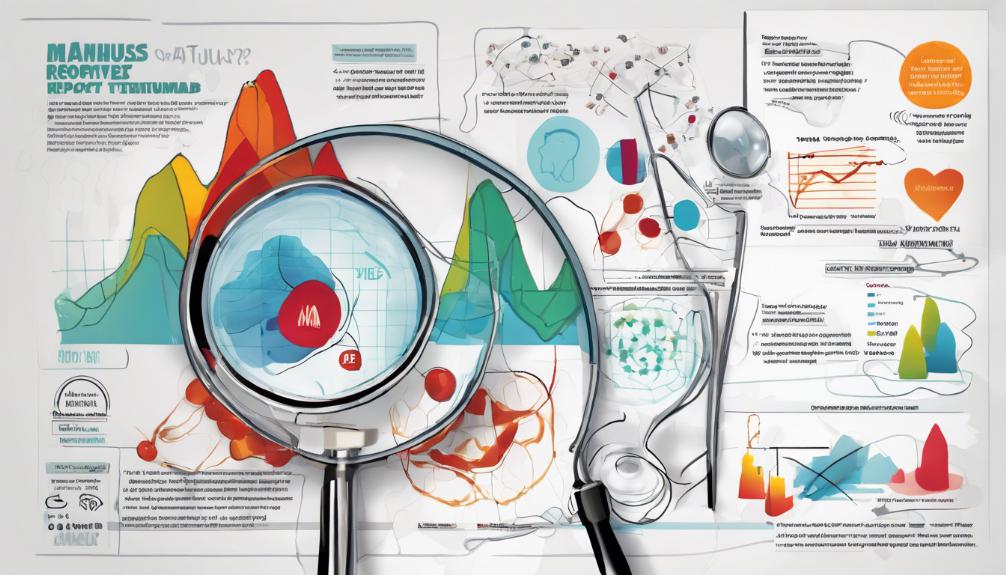Hearing Loss and Teprotumumab
The introduction of Teprotumumab as a treatment for Thyroid Eye Disease (TED) has been a significant advancement, offering relief to many patients suffering from this autoimmune inflammatory condition. However, the emergence of hearing loss as a potential side effect raises critical questions about the drug's safety profile. This concern, highlighted by research from Stanford University, points to a complex interplay between the therapeutic benefits of Teprotumumab and its auditory risks. As we embark on a deeper examination of this issue, it becomes imperative to balance the drug's efficacy in treating TED against the potential for hearing impairment, thus underscoring the need for a careful reconsideration of treatment protocols in affected patients.

Background on TED
What exactly is Thyroid Eye Disease (TED), and why does it warrant attention in the medical community? TED, an autoimmune inflammatory disorder, primarily affects the orbit around the eye, leading to debilitating symptoms such as eye bulging (proptosis), double vision, and in severe cases, vision loss. Its association with thyroid dysfunction, particularly Graves' disease, underlines a complex interplay between systemic and ocular health. The disease's unpredictable course, ranging from mild discomfort to severe, life-altering complications, emphasizes the need for heightened awareness and advanced therapeutic options. Researchers like Andrea Kossler, Connie Martin Sears, and Chrysoula Dosiou from Stanford University have contributed significantly to understanding TED, highlighting its impact on patients' quality of life and the urgent need for effective treatments.
Teprotumumab Approval

In 2020, the U.S. Food and Drug Administration (FDA) granted approval to teprotumumab as the inaugural treatment specifically for Thyroid Eye Disease (TED), marking a significant advancement in the management of this challenging autoimmune condition. This approval highlighted a watershed moment in therapeutic interventions for TED, offering hope to patients who previously had limited treatment options. Teprotumumab, a fully human monoclonal antibody, targets the insulin-like growth factor I receptor (IGF-IR), a novel mechanism of action that has demonstrated efficacy in reducing the clinical activity of TED, including the reduction of proptosis (eye bulging) and improvement in diplopia (double vision), which are significant contributors to the disease's morbidity. This development represents a pivotal shift in the treatment paradigm for patients suffering from TED.
Research Team Overview

Having outlined the significant approval of teprotumumab for Thyroid Eye Disease (TED), it is crucial to highlight the contributions of the research team spearheaded by Andrea Kossler, Connie Martin Sears, and Chrysoula Dosiou. These researchers, affiliated with Stanford University and its school of medicine, have played pivotal roles in the groundbreaking study leading to the drug's approval. Kossler and Sears, based in Menlo Park and Palo Alto, CA, respectively, alongside Dosiou from Atherton, have collectively published numerous articles detailing their findings on TED and teprotumumab. Their collaborative efforts not only underscore the interdisciplinary approach required in medical research but also exemplify the dedication needed to bring forth innovative treatments in the realm of autoimmune and inflammatory diseases.
Study Outcomes

The study revealed that teprotumumab, the first FDA-approved drug for Thyroid Eye Disease (TED), significantly improves symptoms such as proptosis and double vision while enhancing patients' quality of life. This groundbreaking research, led by notable scholars from Stanford University, underscores the therapeutic potential of teprotumumab in addressing the debilitating aspects of TED. Proptosis, a hallmark symptom of the disease characterized by the bulging of the eye, saw notable improvement, alongside a reduction in diplopia or double vision, which profoundly impacts daily activities and mental health. These outcomes suggest that teprotumumab not only ameliorates physical symptoms but also contributes to overall well-being, marking a significant advancement in TED management.
Hearing Loss Concerns

Amid the advancements in treating Thyroid Eye Disease with teprotumumab, concerns have emerged regarding hearing loss as a potential side effect in some patients. This development has drawn significant attention from the medical community, as teprotumumab represents a groundbreaking treatment for a condition previously managed through more invasive methods. The reported incidence of hearing loss symptoms among patients, although relatively low at around 10%, necessitates a careful consideration of the drug's risk-benefit ratio. The implications of these findings are critical, not only for those currently undergoing treatment but also for prospective patients. It underscores the importance of vigilant monitoring for auditory symptoms and highlights the need for further research to understand the underlying mechanisms driving this side effect.
Patient Side Effects

In the context of treating thyroid eye disease with teprotumumab, a significant proportion of patients, approximately 85%, have reported experiencing side effects. These adverse effects range in severity and encompass a variety of symptoms, which include but are not limited to muscle spasms, nausea, hair loss, fatigue, and notably, hearing impairment. About 10% of patients have reported symptoms related to hearing loss, raising concerns among healthcare providers and researchers. The occurrence of such side effects has prompted further investigations into the drug's safety profile and its impact on patients undergoing treatment. While teprotumumab represents a breakthrough in the management of thyroid eye disease, the prevalence of these side effects necessitates careful consideration and monitoring to mitigate potential risks and enhance patient care.
Quality of Life Improvements

While addressing the side effects of teprotumumab is crucial, it is equally important to recognize the significant improvements in quality of life reported by patients treated for thyroid eye disease. The advent of teprotumumab as the first FDA-approved medication for this condition marks a pivotal moment in the management of thyroid eye disease, offering hope to those who have suffered from its debilitating symptoms. Research conducted by Andrea Kossler and her colleagues at Stanford University has underscored the transformative impact of this treatment on patients' daily lives. Beyond the measurable physical improvements, patients have reported a profound positive shift in their emotional well-being and social interactions, underscoring the holistic benefits of teprotumumab in treating thyroid eye disease.
Proptosis and Double Vision

Teprotumumab has shown remarkable efficacy in treating proptosis and double vision, key symptoms of thyroid eye disease, according to recent studies. Researchers from Stanford University, including Andrea Kossler, Connie Martin Sears, and Chrysoula Dosiou, have contributed significantly to our understanding of this treatment. Their work demonstrates that teprotumumab not only improves these specific symptoms but also enhances the overall quality of life for patients suffering from this autoimmune inflammatory disease. Noteworthy is the fact that these benefits have been observed consistently across various studies, underscoring teprotumumab's potential as a transformative treatment option. However, it's important to note that while the drug shows promising results, a subset of patients experienced side effects, highlighting the need for careful patient monitoring.
FDA Drug Journey

Having examined the therapeutic benefits and side effects of teprotumumab in treating thyroid eye disease, it is essential to explore the regulatory pathway that led to its approval by the FDA in 2020. The journey began with rigorous clinical trials designed to assess the drug's efficacy and safety profile in patients suffering from TED. These studies demonstrated significant improvements in symptoms such as proptosis and double vision, marking a breakthrough in the management of this condition. Following the submission of compelling clinical data, the FDA granted teprotumumab a fast track designation, recognizing the unmet medical need in treating TED. This expedited review process culminated in the drug's approval, offering a novel therapeutic option to patients with this challenging disease.
Safety Profile Insights

In examining the safety profile of teprotumumab for the treatment of thyroid eye disease, it is crucial to note that 85% of patients reported experiencing side effects, including symptoms of hearing loss in 10% of cases. This data underscores the importance of comprehensive patient monitoring and management strategies to mitigate these adverse effects. The high incidence of side effects, while concerning, must be balanced against the significant therapeutic benefits teprotumumab offers, including marked improvements in proptosis, double vision, and overall quality of life for patients with thyroid eye disease. Healthcare providers are encouraged to discuss potential risks with patients and to conduct regular auditory evaluations as part of the management plan for those undergoing teprotumumab therapy.
Article Access and Rights

Understanding the implications of teprotumumab's side effects, it is equally important to explore how access to and rights concerning pertinent research findings are managed. The article in question, published by Oxford University Press for the Endocrine Society, is an open-access document. This means that the research findings can be freely accessed by the public, allowing for widespread dissemination of knowledge. The copyright is retained by the authors, but the licensing details provided ensure that the information can be shared and utilized for further research under specified conditions. This approach supports the broader scientific and medical communities in their efforts to understand, discuss, and address the side effects of teprotumumab, particularly hearing loss, thereby promoting informed medical practices and patient care.
Research Affiliations

The study on teprotumumab's effects on thyroid eye disease, revealing insights into associated hearing loss, was spearheaded by researchers affiliated with Stanford University, including prominent figures such as Andrea Kossler, Connie Martin Sears, and Chrysoula Dosiou. These researchers have distinct affiliations within the Stanford ecosystem, each bringing a unique perspective and expertise to the study. Andrea Kossler is associated with Stanford University in Menlo Park, CA, USA, while Connie Martin Sears and Chrysoula Dosiou are affiliated with the institution's Palo Alto and School of Medicine in Atherton, CA, USA, locations, respectively. Their collective efforts have significantly contributed to understanding the multifaceted impacts of teprotumumab, marking an important step in the treatment of thyroid eye disease and its complications.
Future Implications

Reflecting on the insights gained from the Stanford University study on teprotumumab's effects on thyroid eye disease, it becomes imperative to explore the future implications of these findings for both treatment strategies and patient care. The recognition of hearing loss as a side effect in a significant subset of patients necessitates a reevaluation of the drug's risk-benefit ratio. Future research should aim at identifying predisposing factors for adverse effects, potentially enabling personalized treatment plans. Moreover, ongoing monitoring and early detection protocols for hearing impairment must be integrated into the patient care regimen. These steps will ensure that the therapeutic benefits of teprotumumab are harnessed optimally while minimizing the risk to patients' auditory health, thereby refining the management of thyroid eye disease.
Frequently Asked Questions
How Does Teprotumumab's Mechanism of Action Potentially Relate to Auditory Function or Hearing Loss?
The inquiry centers on elucidating the mode of action of teprotumumab and its potential implications on auditory capabilities or the emergence of hearing loss. Teprotumumab operates by targeting the insulin-like growth factor 1 receptor (IGF-1R), inhibiting its activity. This mechanism is essential in understanding its therapeutic effects in conditions it is approved for, as well as its side effects, which could potentially include impacts on auditory functions.
Are There Specific Populations or Patient Subgroups That Are at a Higher Risk of Developing Hearing Loss When Treated With Teprotumumab?
The inquiry seeks to identify particular groups or demographics that may exhibit an increased susceptibility to adverse auditory outcomes following a specific treatment. It is essential to scrutinize patient characteristics, including pre-existing conditions, genetic predispositions, and other relevant factors, to ascertain any heightened risk. Such an analysis is crucial for developing tailored therapeutic approaches and mitigating potential side effects, thus ensuring a more personalized and effective treatment regimen.
Can the Hearing Loss Associated With Teprotumumab Treatment Be Reversed, and if So, What Are the Treatment Options Available?
The question inquires about the reversibility of hearing loss and available treatment options. While specific context is omitted, generally, hearing loss can sometimes be reversible, depending on its cause. Treatment options vary and may include medications, surgical interventions, or the use of hearing aids and other assistive devices. Consulting a healthcare professional is essential for an accurate diagnosis and to determine the most appropriate treatment plan based on individual circumstances.
Are There Any Preventative Measures That Patients Can Take to Minimize the Risk of Hearing Loss Before Starting Teprotumumab Treatment?
To mitigate potential auditory health risks prior to initiating treatment, patients are advised to undergo comprehensive hearing assessments. This preemptive approach facilitates the identification of pre-existing auditory conditions, enabling tailored management strategies. Additionally, closely monitoring auditory function throughout treatment allows for the early detection of any adverse effects, ensuring prompt intervention. Adhering to these guidelines significantly contributes to preserving auditory health, thereby enhancing overall treatment outcomes and patient quality of life.
How Do Healthcare Providers Typically Monitor Patients for Early Signs of Hearing Loss During the Course of Teprotumumab Treatment?
Healthcare providers typically employ a proactive approach to monitor patients for early signs of potential adverse effects during specific treatments. This involves regular assessments through medical examinations, auditory tests, and patient-reported symptoms to detect any changes in hearing. Early detection is critical for implementing preventative measures or adjusting treatment plans to mitigate risks. Patient education about recognizing and reporting symptoms promptly is also an integral part of the monitoring strategy.

This post has been generated by AI and was not reviewed by editors. This is Not legal advice. Please consult with an attorney.




